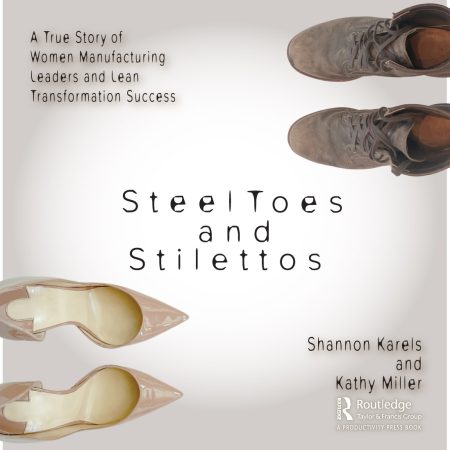
Women making manufacturers leaner and more profitable
Adam Dras
News Women in Manufacturing ippt manufacturing women
Kathy Miller is a manufacturing executive responsible for a business’s profitability and all the lives that the company supports.
Together with Shannon Karels who was hired by Miller to be a part of her divisional leadership team — they are now responsible for a $75 million operation with hundreds of team members at four locations in two countries.
Their new book, Steel Toes and Stilettos, details how they developed a high-performing team and transformed multiple plants into a lean enterprise, with all the accompanying business performance improvements. It is also a story of friendship — how it grew from mere business acquaintances to a sisterhood.
Written from each of their perspectives — from an executive position with P&L responsibility and from the Lean leader responsible for the transformation — readers will learn techniques for improving results and engagement at any organization. Advocating that lean transformation and inclusive culture improve key performance metrics, the authors also show how it enables a work environment that is safe and drives value for the customer.
Join us for our free March 22 online virtual summit, Advance: Women in Manufacturing
I sat down with Kathy to learn more about what the book is all about, and how women can flourish in the process manufacturing sector.
IPP/T: The new book, Steel Toes and Stilettos, how did that all begin?
Miller: As a result of our time working together on transforming multiple plants from traditional batch manufacturing to lean enterprises, our friendship grew to be that of more like family. Once our careers took us down different paths, we committed to spending time together as much as possible.

Kathy Miller
During one of these visits, we were reminiscing about the great results we achieved from our lean transformations and what we did to drive those business improvements. That’s when we realized we had a really good story to share, and others may benefit from our experiences. Plus, we thought the book could serve as inspiration for young women to see successful women in leadership roles in manufacturing.
How important is it to encourage a greater female presence in the manufacturing sector?
Manufacturing offers rewarding careers for so many people with varying talents, interests, and skillsets. We would encourage everyone to consider what the manufacturing sector has to offer. However, we do believe that more balance in terms of gender would benefit manufacturing, as diversity of thought facilitates creativity, which is a key ingredient in generating positive business results.
What are the keys to encouraging more women into the manufacturing workforce?
One of the keys to encouraging more women into the manufacturing workforce, especially those who are early in the process of deciding on their educational and career paths, is educating students on what manufacturing looks like today. Many facilities in the manufacturing sector are clean and safe and have implemented or are in the process of implementing advanced technologies as the world continues to evolve in this digital era.
It is important for women who enjoy this sector to share their stories with the next generation, whether they work on equipment, lead teams, or fulfill one of the many functional roles required to create value for customers. Having a diverse set of manufacturing representatives speak of how their work in manufacturing is rewarding for them will help a diverse set of candidates envision what their futures could look like as well.
What have traditionally been the obstacles that have been removed, or need to be removed?
There is an increasing recognition that people want more flexibility to balance both the personal and professional aspects of their lives. While the pandemic has done a lot to further that cause, there is still a way to go. Manufacturing has the challenge that many other sectors do not have, in that physical work must be performed and supported to achieve the mission, and as such, some of the tools that professional service sectors can use to provide flexibility to employees are a bit more of a challenge. Still, creativity can be used to find ways to facilitate more balance in schedules, employee support, and so forth.
There is also now than in years past, what is appropriate and inappropriate language and behavior in the work environment – so that is less of an obstacle – particularly when people want to go to a place of employment that is healthy in terms of culture.
Finally, there needs to be continued emphasis on hiring and promoting the very best people for a job, regardless of gender, race, ethnicity, etc. People want opportunities to contribute based on the talents they bring.
How can business bottom lines improve by promoting an inclusive culture?
Inclusive cultures ensure that all voices are heard and contributions are valued. This leads to more creative and comprehensive solutions to problems and opportunities that arise. When people are able to express their concerns and help resolve issues, they tend to have more buy-in and ownership of the work that is being done.
The positive relationships that are fostered through mutual respect between leaders and workers, and among peers create a feeling of being part of something bigger than oneself and bring meaning to the work that is performed. This evokes energy and motivation toward generating successful results.
You have both developed a friendship from collaborating on the book – how has that made you both more effective leaders?

Shannon Karels
We have very different strengths and personalities and believe by acknowledging and capitalizing on those differences, we learn from each other and can bolster the other’s efforts when needed. We continue to foster trust and honesty as part of our relationship, and truly want to continue to grow as leaders and good human beings.
Print this page